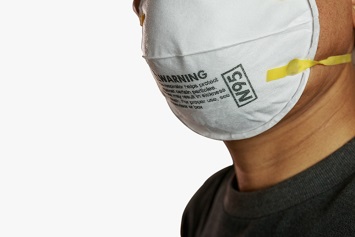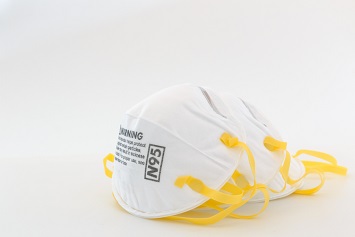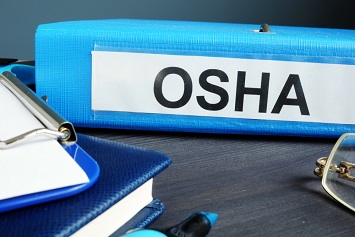Why are there still shortages of N95 filtering facepiece respirators (FFRs)? Basically, when the coronavirus disease 2019 (COVID-19) pandemic was declared in March, a spike in demand for N95 respirators met a “just-in-time” supply chain. Both industry and government have moved to address shortages. COVID-19 is a respiratory disease caused by an infection of the SARS-CoV-2 virus.
Manufacturers have ramped up production, and federal agencies, including the Occupational Safety and Health Administration (OSHA), have issued guidance or made certain allowances for respirator shortages.
But make no mistake: OSHA enforcement goes on. On July 21, the agency announced it had cited Ohio-based healthcare company OHNH EMP LLC for violations of the respiratory protection standard after the coronavirus-related hospitalizations of seven employees. OSHA proposed penalties totaling $40,482. The agency discovered the employer had adopted a policy allowing N95 respirator use for up to 7 days and had discontinued conducting initial fit testing.
While OSHA has provided exemptions or exercised discretion in enforcement of respiratory protection requirements in healthcare settings, those do not extend to its substance-specific standards for nonhealthcare industries, like the construction, general industry, and maritime standards for asbestos and silica. The agency does not allow the substitution of cloth face coverings or surgical masks for N95 respirators. Employers that lack a sufficient supply of respirators still must comply with permissible exposure limits, substituting materials, using other control methods like local exhaust ventilation, or postponing tasks and processes altogether until appropriate personal protective equipment (PPE) become available.
This summer, the agency reminded employers that exceptions from respiratory protection regulations allowing the use of surgical masks only apply to healthcare facilities and emergency medical services.
OSHA Enforcement Discretion
However, OSHA has allowed inspectors and field offices to exercise discretion at healthcare facilities in enforcing the annual fit-testing requirements of the respiratory protection standards. Employers must inform workers if annual fit testing is temporarily suspended to preserve and prioritize the supply of N95 FFRs, explain the importance to workers of performing a user seal check each time they don FFRs, and remind workers they should inform a supervisor if the integrity and/or fit of their N95 FFR is compromised.
An N95 FFR has become a much sought-after piece of PPE during the COVID-19 pandemic. N95 respirators are used in a variety of settings, but all must be capable of filtering 95% of particulate matter.
N95 respirators are used in healthcare settings, as well as construction, mining, oil and gas extraction, and other industries. Employers in California must provide them to protect employees from wildfire smoke when the Air Quality Index (AQI) for airborne particulate matter two and one-half microns or less in width (PM 2.5) exceeds 500. Certain substance-specific standards require them when elimination and substitution and engineering and administrative controls cannot reduce exposures to below the permissible exposure limit (PEL).
There also are multiple types of N95s, depending on the use and workplace setting. N95 respirators for use in healthcare facilities during certain procedures typically must meet more stringent requirements than industrial N95s. However, the use of industrial FFRs in healthcare settings currently is allowed to address supply shortages during the pandemic.
N95 Oversight Regulation
Two federal agencies oversee the regulation and approval of N95 FFRs: the Food and Drug Administration (FDA) and National Institute for Occupational Safety and Health (NIOSH). NIOSH tests all respirators for occupational use. The FDA has standards for N95 FFRs used in healthcare settings and surgical N95 respirators. The FDA also has standards for surgical masks, which are fluid-resistant, disposable, and loose-fitting devices that create a physical barrier between the mouth and the nose of the wearer and the immediate environment. They are for use in surgical settings and do not provide full protection from inhalation of airborne pathogens. NIOSH does not test or approve surgical masks.
Surgical N95 respirators are single-use, disposable respiratory protective devices worn by healthcare personnel during certain procedures to protect both the patient and the healthcare worker from the transfer of body fluids, microorganisms, and particulate material.
NIOSH tests manufacturers’ N95 FFRs for use in healthcare and surgical N95 respirators for compliance with the FDA’s standards.
Some healthcare facilities instruct patients and visitors to wear surgical masks to prevent the wearers from infecting others. Cloth face coverings, often homemade, can capture the wearers’ aerosolized particles and protect others from any infections.
The Centers for Disease Control and Prevention (CDC) has recommended the general public wear cloth face coverings to reduce the spread of COVID-19. OSHA and several state workplace safety and health agencies have recommended the use of cloth face coverings along with social distancing (separating individuals by a minimum of 6 feet) during the reopening of many workplaces.
Some infectious disease researchers have speculated that cloth masks, depending on the layers and materials used, may protect wearers from infection or protect them from severe disease by reducing the wearers’ viral load. However, there is no peer-reviewed evidence for the protective value of cloth masks, and cloth masks are not approved respiratory protection.
Manufacturers’ Response
Several makers of N95 FFRs announced increased production this spring. 3M ramped up production of N95 respirators beginning in January, according to a company statement, doubling its global output to 1.1 billion per year, including 35 million a month in the United States. By late spring, 3M and Ford began shipping newly designed powered air-purifying respirators (PAPRs) for healthcare workers fighting COVID-19.
The limited-use public health emergency PAPR, which incorporates fan components found in the Ford F-150’s ventilated seats, includes a hood and face shield to cover healthcare professionals’ heads and shoulders, and a high-efficiency particulate air (HEPA) filter system provides a supply of filtered air for up to 8 hours on a single battery charge.
The FDA Emergency Use Authorization (EUA) only authorizes use of the Ford/3M PAPR in healthcare settings during the COVID-19 pandemic and does not permit use of this product by the general public, according to the PAPR’s product notice.
3M also has had to combat price gouging and sellers offering counterfeit masks. 3M has filed several lawsuits to combat counterfeiting, fraud, and price gouging in Canada and the United States. 3M had secured the removal of over 7,000 e-commerce listings with fraudulent or counterfeit product offerings from e-commerce platforms around the world and over 10,000 false or deceptive social media posts as of August 19.
Moldex, a maker of industrial N95 respirators for construction, defense, mining, and oil and gas extraction workplace settings, announced it had hired additional personnel and added production shifts, nearing the manufacturer’s capacity. The FDA granted emergency use authorization of industrial respirators while healthcare N95 respirators remained in short supply during the pandemic.
Honeywell began production of N95 masks at its Smithfield, Rhode Island, facility to supply masks for the Department of Health and Human Services’ (HHS) Strategic National Stockpile to support emergency response, health, and safety workers. Honeywell’s Smithfield factory had been dedicated to producing the company’s UVEX-branded eye protection products, including safety glasses, safety goggles, and protective face shields.
Honeywell also expanded N95 respirator production to its Phoenix facility, which had been dedicated to production of aircraft propulsion systems and auxiliary power units. The company predicted the two facilities could produce more than 20 million N95 disposable masks monthly, according to a company statement.
Counterfeit respirators and fraudulent vendors have become a huge headache for employers. NIOSH has maintained a searchable, online database of NIOSH-approved respirators known as the Certified Equipment List since 1994. The institute also maintains a page of respirator trusted-source information, with links to a list of NIOSH-approved respirators, the use of NIOSH respirators, and frequently asked questions addressing issues like medical evaluation, respirator selection, fit testing, and training requirements.
Agency Interventions
The FDA, the CDC, and OSHA also took steps to address respirator supply problems brought on by the pandemic. These included allowing the extended use and reuse of N95 respirators, the use of industrial N95 respirators in healthcare settings, the use of stockpiles of expired respirators, and the use of foreign-manufactured FFRs not approved by OSHA but certified by foreign governments for 95% filtering efficiency.
OSHA issued enforcement guidance recognizing emergency use of specific respirators produced in Australia, Brazil, China, the European Union, Japan, Korea, and Mexico. The CDC, the FDA, and OSHA also have temporarily allowed the decontamination and reuse of disposable respirators, but decontamination may compromise the effectiveness of respirators.
The CDC and NIOSH issued guidance for the use of ultraviolet germicidal irradiation, vaporous hydrogen peroxide, and moist heat, which had shown the most promise as potential methods of decontaminating FFRs. However, the FDA later announced the certain foreign-made FFRs should not be decontaminated for reuse. NIOSH had found certain respirators manufactured in China may vary in their design and performance.
However, the respirator exceptions do not apply to healthcare personnel performing aerosol-generating procedures on patients with confirmed or suspected COVID-19 infections.
Foreign-manufactured FFRs have not been tested by NIOSH for approval, but the institute’s National Personal Protective Technology Laboratory (NPPTL) has performed assessments of many using a modified version of NIOSH Standard Test Procedure (STP) TEB-APR-STP-0059. The NPPTL maintains respirator assessment results and test reports on its website.
The NPPTL recently recognized Respirator Protection Week September 8–11. Events included a webinar on factors to consider when planning to purchase respirators from another country, including KN95 respirators from China; a recording is available.
Enforcement Goes On
But as OSHA’s enforcement actions demonstrate, there are limits to the discretion inspectors and field offices are able to exercise even in healthcare settings. For example, enforcement personnel must weigh whether an employer in a healthcare facility has made a good-faith effort to obtain other alternative FFRs, reusable elastomeric respirators, or PAPRs appropriate to protect workers and whether employers have monitored their supply of N95s and prioritized their use according to CDC guidance.
While inspectors may not cite the use of surgical masks and eye protection such as face shields and goggles as an interim measure to protect against splashes and large droplets, respiratory protection still is necessary in aerosol-generating procedures.
Inspectors also will weigh whether other feasible measures like the use of partitions; restricting access; “cohorting” patients; or other engineering controls, work practices, or administrative controls to reduce the need for respiratory protection were implemented to protect employees.



